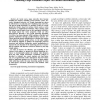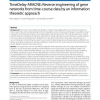65 search results - page 11 / 13 » Methods for Random Modularization of Biological Networks |
ICDM
2006
IEEE
13 years 11 months ago
2006
IEEE
There is a need to develop methods to automatically incorporate prior knowledge to support the prediction and validation of novel functional associations. One such important sourc...
ICDM
2010
IEEE
13 years 3 months ago
2010
IEEE
In recent years, many networks have become available for analysis, including social networks, sensor networks, biological networks, etc. Graph clustering has shown its effectivenes...
BCB
2010
13 years 20 days ago
2010
We present a new method for identifying gene sets associated with labeled samples, where the labels can be case versus control, or genotype differences. Existing approaches to thi...
BMCBI
2010
13 years 5 months ago
2010
Background: One of main aims of Molecular Biology is the gain of knowledge about how molecular components interact each other and to understand gene function regulations. Using mi...
RECOMB
2003
Springer
14 years 6 months ago
2003
Springer
We develop an integrated probabilistic model to combine protein physical interactions, genetic interactions, highly correlated gene expression network, protein complex data, and d...


